Tait TMAB1Z External Radio Frequency Power Amplifier User Manual TM9100 Installation Guide
Tait Limited External Radio Frequency Power Amplifier TM9100 Installation Guide
Tait >
Exhibit D Users Manual per 2 1033 c3
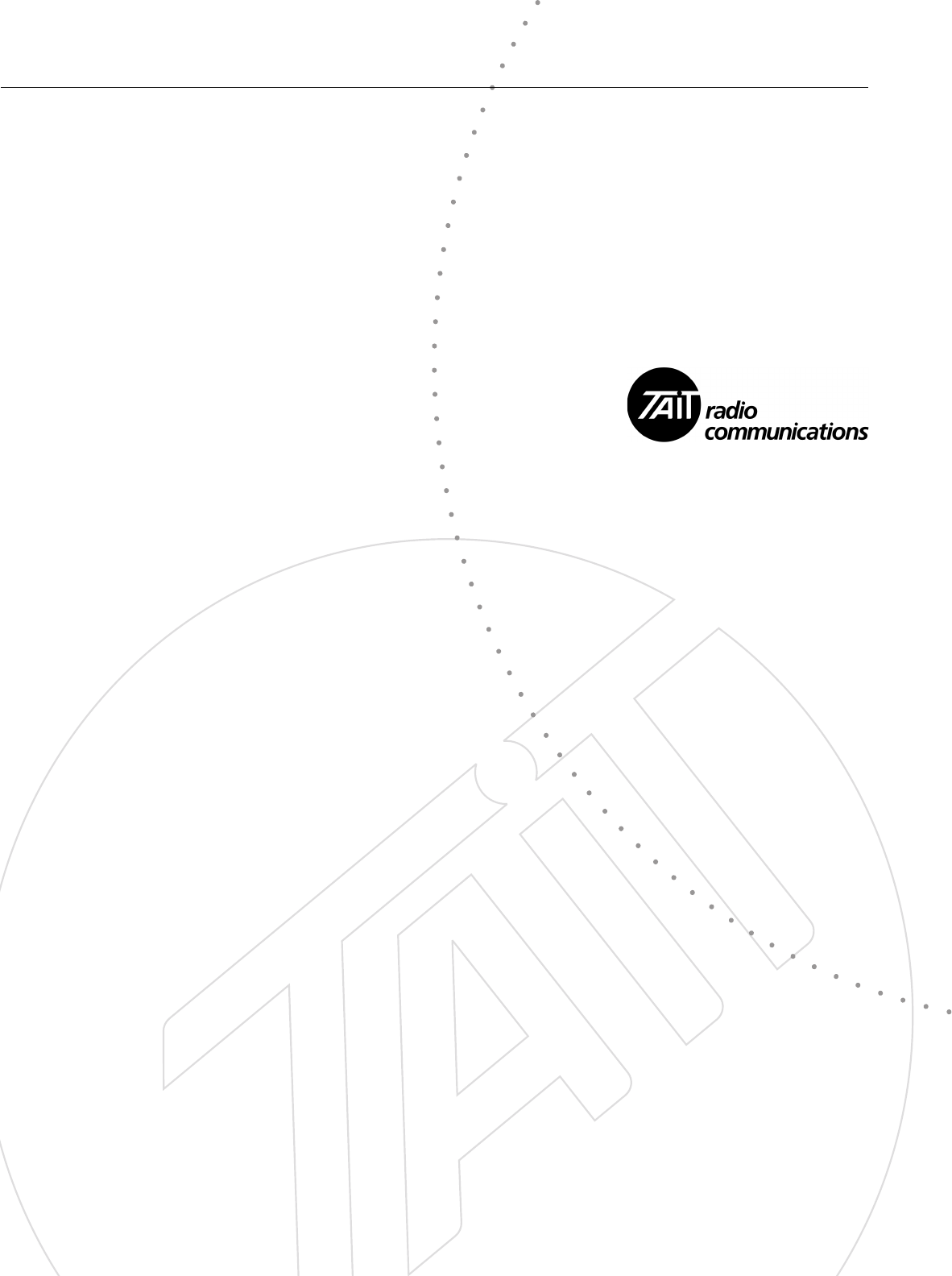
TM9100 mobiles
110 Watt Mobile
Installation Guide
27 October 2005

2 Contact information TM9100 Mobiles: 110 W Mobile Installation Guide
© Tait Electronics Limited October 2005
Contact information
Tait Radio Communications
Corporate Head Office
Tait Electronics Ltd
P.O. Box 1645
Christchurch
New Zealand
For the address and telephone number of
regional offices, refer to the TaitWorld
website:
Websit e: http://www.taitworld.com
Technical Support
For assistance with specific technical issues,
contact Technical Support:
E-mail: support@taitworld.com
Website : http://support.taitworld.com
To our European customers:
Tait Electronics Limited is an environmentally responsible company which
supports waste minimization and material recovery. The European Union’s
Waste Electrical and Electronic Equipment Directive requires that this
product be disposed of separately from the general waste stream when its
service life is over. Please be environmentally responsible and dispose
through the original supplier, your local municipal waste “separate collec-
tion” service, or contact Tait Electronics Limited.
TM9100 Mobiles: 110 W Mobile Installation Guide 3
© Tait Electronics Limited October 2005
Preface . . . . . . . . . . . . . . . . . . . . . . . . . . . . . . . . . . . . . . . . . . . . . . . . . 4
Scope of Manual. . . . . . . . . . . . . . . . . . . . . . . . . . . . . . . . . . . . . . . . . . . . . . . . . 4
Enquiries and Comments . . . . . . . . . . . . . . . . . . . . . . . . . . . . . . . . . . . . . . . . . . 4
Updates of Manual and Equipment . . . . . . . . . . . . . . . . . . . . . . . . . . . . . . . . . . . 4
Copyright. . . . . . . . . . . . . . . . . . . . . . . . . . . . . . . . . . . . . . . . . . . . . . . . . . . . . . 4
Disclaimer . . . . . . . . . . . . . . . . . . . . . . . . . . . . . . . . . . . . . . . . . . . . . . . . . . . . . 4
Associated Documentation . . . . . . . . . . . . . . . . . . . . . . . . . . . . . . . . . . . . . . . . . 5
Document Conventions . . . . . . . . . . . . . . . . . . . . . . . . . . . . . . . . . . . . . . . . . . . 5
1 Introduction . . . . . . . . . . . . . . . . . . . . . . . . . . . . . . . . . . . . . . . . . . . 7
2 Safety Warnings . . . . . . . . . . . . . . . . . . . . . . . . . . . . . . . . . . . . . . . . 8
RF Exposure Hazard . . . . . . . . . . . . . . . . . . . . . . . . . . . . . . . . . . . . . . . . . . . . . 8
Safe Radio Mounting . . . . . . . . . . . . . . . . . . . . . . . . . . . . . . . . . . . . . . . . . . . . . 8
Correct Fuse Rating . . . . . . . . . . . . . . . . . . . . . . . . . . . . . . . . . . . . . . . . . . . . . . 8
Interference with Vehicular Electronics . . . . . . . . . . . . . . . . . . . . . . . . . . . . . . . . 8
Preparation when Drilling Holes . . . . . . . . . . . . . . . . . . . . . . . . . . . . . . . . . . . . . 9
Vehicles Powered by Liquefied Petroleum Gas. . . . . . . . . . . . . . . . . . . . . . . . . . . 9
Radio Installation in Gas or Fuel tankers . . . . . . . . . . . . . . . . . . . . . . . . . . . . . . . 9
Negative Earth Supply . . . . . . . . . . . . . . . . . . . . . . . . . . . . . . . . . . . . . . . . . . . . 9
3 Preparing the Installation . . . . . . . . . . . . . . . . . . . . . . . . . . . . . . . . . 10
3.1 Regulations . . . . . . . . . . . . . . . . . . . . . . . . . . . . . . . . . . . . . . . . . . . . . . 10
3.2 Installation Tools. . . . . . . . . . . . . . . . . . . . . . . . . . . . . . . . . . . . . . . . . . . 10
3.3 Checking the Equipment for Completeness . . . . . . . . . . . . . . . . . . . . . . . 10
3.4 Programming Settings . . . . . . . . . . . . . . . . . . . . . . . . . . . . . . . . . . . . . . . 11
4 Installing the Radio . . . . . . . . . . . . . . . . . . . . . . . . . . . . . . . . . . . . . 12
4.1 Selecting the Mounting Position . . . . . . . . . . . . . . . . . . . . . . . . . . . . . . . 12
4.2 Installing the Antenna . . . . . . . . . . . . . . . . . . . . . . . . . . . . . . . . . . . . . . . 13
4.3 Connecting the Power Cable to the Power Source . . . . . . . . . . . . . . . . . . 14
4.4 Installing the Remote Control Head . . . . . . . . . . . . . . . . . . . . . . . . . . . . 15
4.5 Installing the Microphone . . . . . . . . . . . . . . . . . . . . . . . . . . . . . . . . . . . . 16
4.6 Connecting to the Ignition Signal . . . . . . . . . . . . . . . . . . . . . . . . . . . . . . 17
4.7 Connecting a Remote Speaker . . . . . . . . . . . . . . . . . . . . . . . . . . . . . . . . 18
4.8 Connecting to an Emergency Switch and/or External Alert Devices . . . . . 18
4.9 Mounting the Radio . . . . . . . . . . . . . . . . . . . . . . . . . . . . . . . . . . . . . . . . 20
4.10 Checking the Installation. . . . . . . . . . . . . . . . . . . . . . . . . . . . . . . . . . . . . 22
Tait General Software Licence Agreement . . . . . . . . . . . . . . . . . . . . . . . . 23

4Preface TM9100 Mobiles: 110 W Mobile Installation Guide
© Tait Electronics Limited October 2005
Preface
Scope of Manual
This manual describes how to install a Tait TM9155R mobile, including
microphone, antenna, emergency switch, and external alert device.
The installation of accessories is described in the installation instructions
provided with the equipment, and the relevant section in the service
manual.
Enquiries and Comments
If you have any enquiries regarding this manual, or any comments,
suggestions or notifications of errors, please contact Technical Support, Tait
Electronics Ltd, Christchurch, New Zealand (refer to “Contact
information” on page 2).
Updates of Manual and Equipment
In the interests of improving the performance, reliability, or servicing of the
equipment, Tait Electronics Ltd reserves the right to update the equipment
or this manual or both without prior notice.
Copyright
All information contained in this manual is the property of Tait Electronics
Ltd. All rights are reserved. This manual may not, in whole or in part, be
copied, photocopied, reproduced, translated, stored, or reduced to any
electronic medium or machine-readable form, without prior written
permission from Tait Electronics Limited. All trade names referenced are the
service mark, trademark or registered trademark of the
respective manufacturers.
Disclaimer
There are no warranties extended or granted by this manual. Tait Electronics
Ltd accepts no responsibility for damage arising from use of the information
contained in the manual or of the equipment and software it describes.
It is the responsibility of the user to ensure that use of such information,
equipment and software complies with the laws, rules and regulations of the
applicable jurisdictions.

TM9100 Mobiles: 110 W Mobile Installation Guide Preface 5
© Tait Electronics Limited October 2005
Associated Documentation
■TM9100 User’s Guide (MMA-00001-01)
■TM9100 Service Manual (MMA-00017-01)
■Technical notes are published from time to time to describe applications
for Tait products, to provide technical details not included in manuals,
and to offer solutions for any problems that arise.
All available TM9100 product documentation is provided on the CD
supplied with the service kit1. Updates may also be published on the Tait
support website.
Document Conventions
Within this manual, four types of alerts are given to the reader: Warning,
Caution, Important and Note. The following paragraphs illustrate each type
of alert and its associated symbol.
Warning!! This alert is used when there is a potential risk of death
or serious injury.
Caution This alert is used when there is the risk of minor or moderate
injury to people.
Important This alert is used to warn about the risk of equipment
damage or malfunction.
Note This alert is used to highlight information that is required to ensure
procedures are performed correctly.
1. Technical notes are only available in PDF format from the Tait
support website. Consult your nearest Tait Dealer or Customer
Service Organization for more information.
6Preface TM9100 Mobiles: 110 W Mobile Installation Guide
© Tait Electronics Limited October 2005
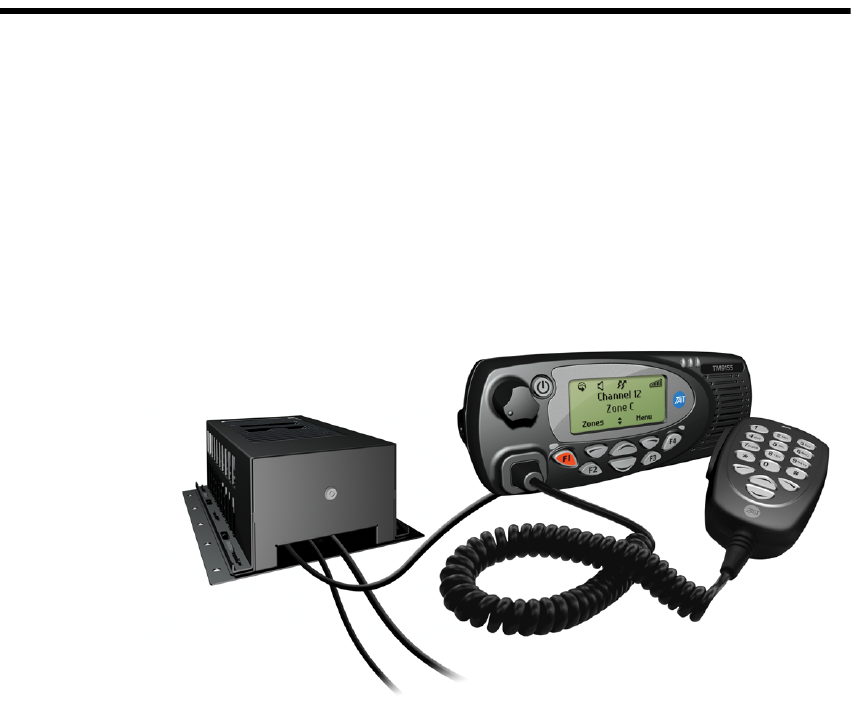
TM9100 Mobiles: 110 W Mobile Installation Guide Introduction 7
© Tait Electronics Limited October 2005
1 Introduction
The Tait TM9155R mobile is a P25-compliant radio in the VHF (136-174
MHz) frequency range with 110 W transmit power output. It consists of a
standard TM9100 mobile enclosed in a strong chassis on top of which is an
external RF amplifier. The TM9155R comes complete with remote control
head, microphone, and install kit. An optional base plate and cover provide
secure ‘quick-release’ mounting and additional protection against water and
physical impact. The TM9155R is already fitted with an Ignition Sense kit.
The TM9155R is designed to be trunk-mounted, with the remote control
head mounted in the vehicle cabin.

8 Safety Warnings TM9100 Mobiles: 110 W Mobile Installation Guide
© Tait Electronics Limited October 2005
2 Safety Warnings
This section contains important information on the safe installation of the
radio. You must read this information before starting the installation.
You must also read and observe the safety information on radio operation
provided in the product safety and compliance information booklet and the
TM9100 user’s guide.
RF Exposure Hazard
To comply with FCC RF exposure limits:
■VHF radios must be installed using an antenna mounted centrally on the
vehicle roof, with a gain of 2.15dBi or 5.15dBi.
The antenna must not be mounted at a location such that any person or
persons can come closer than 44 inches (1.1m) to the antenna.
Safe Radio Mounting
Warning!! Mount the radio securely so that it will not break loose
in the event of a collision. An unsecured radio is
dangerous to the vehicle occupants.
■Do not mount the radio vertically.
Correct Fuse Rating
Warning!! Danger of fire. The radio’s protection mechanisms rely
on the correct fuses on both the negative and positive
power supply leads being present. Failure to fit the
correct fuses may result in fire or damage to the radio.
The correct fuse type is:
■30A fuse (Tait IPN 265-00012-00)
Interference with Vehicular Electronics
Warning!! Some vehicular electronic devices may be prone to
malfunction due to the lack of protection from RF
energy when your radio is transmitting.
Examples of vehicular electronic devices that may be affected by RF
energy are:

TM9100 Mobiles: 110 W Mobile Installation Guide Safety Warnings 9
© Tait Electronics Limited October 2005
■electronic fuel injection systems
■electronic anti-skid braking systems
■electronic cruise control systems
■indicators.
If the vehicle contains such equipment, consult the vehicle manufacturer or
dealer to determine whether these electronic circuits will perform normally
when the radio is transmitting.
Preparation when Drilling Holes
Warning!! When drilling holes in the vehicle, check that drilling
at the selected points will not damage existing wiring,
petrol tanks, fuel lines, brake pipes, or battery cables.
Vehicles Powered by Liquefied Petroleum Gas
Warning!! Radio installation in vehicles powered by LPG
(liquefied petroleum gas) with the LPG container in a
sealed-off space within the interior of the vehicle must
conform to the National Fire Protection Association
Standard NFPA 58. This standard states that the radio
equipment installation must meet the following
requirements:
■The space containing the radio equipment shall be isolated by a
seal from the space containing the LPG container and its fitting.
■Outside filling connections shall be used for the LPG container
and its fittings.
■The LPG container space shall be vented to the outside of
the vehicle.
Radio Installation in Gas or Fuel tankers
Special conditions must be observed when installing a radio on gas and fuel
tankers. Consult your radio provider or Tait-accredited service center for
more details.
Negative Earth Supply
The radios are designed to operate only in a negative earth system.

10 Preparing the Installation TM9100 Mobiles: 110 W Mobile Installation Guide
© Tait Electronics Limited October 2005
3 Preparing the Installation
This section contains the following information to assist you in preparing for
the actual installation:
■regulations
■installation tools
■checking the equipment for completeness
■programming settings
3.1 Regulations
MPT 1362 Code of
Practice TM9100 mobile radios should be installed in accordance with the MPT
1362 Code of Practice.
Vehicle
Manufacturer’s
Installation
Guidelines
Follow your vehicle manufacturer’s guidelines for installing mobile radios.
For more information, contact the vehicle manufacturer’s dealer or refer to
the vehicle manufacturer’s website, for example, http://service.gm.com/
techlineinfo/radio.html (General Motors) or http://www.fordemc.com/
docs/download/Mobile_Radio_Guide.pdf (Ford).
3.2 Installation Tools
The following tools are required to install the radio:
■drill and drill bits
■Pozidriv screwdriver
■RF connector crimp tool
■fuse crimp tool
■in-line RF power meter capable of measuring forward and reflected
power at the operating frequency of the radio.
3.3 Checking the Equipment for Completeness
Unpack the radio and check that you have the following:
■RF amplifier and radio body
■Base plate
■Cover
■Control head (with fitting instructions)
■Microphone
■Remote cable
■Install kit
Before installing, make sure that cable lengths are sufficient.

TM9100 Mobiles: 110 W Mobile Installation Guide Preparing the Installation 11
© Tait Electronics Limited October 2005
3.4 Programming Settings
Make sure that the radio has been correctly programmed before installing it.
Note The radio can only be programmed via the control head
microphone socket, not via the sockets on the dual RJ-45 head.
In particular, programming must have:
■Selected the B1 band.
■Enabled the check box ‘Configure as 110 W mobile’. This modifies the
setting of a number of items, including the power output to the external
RF amplifier.
■Configured the channels that the radio will operate on.
■Configured the AUX_GPI3 line for ignition sense. To do this, program
it as an input, select the action ‘Power Sense (Ignition)’ and specify that
the active state is ‘High’. For more information, refer to the online help
of the application software.
■Configured any inputs and outputs on the auxiliary connector that will
be used for external devices or signals
Important Incorrect programming settings can result in damage to the
external RF amplifier.
For details, see the programming software online Help.

12 Installing the Radio TM9100 Mobiles: 110 W Mobile Installation Guide
© Tait Electronics Limited October 2005
4 Installing the Radio
This section explains how to install and check the radio and its associated
equipment. It contains the following information:
■Selecting the Mounting Position
■Installing the Antenna
■Connecting the Power Cable to the Power Source
■Installing the Remote Control Head
■Installing the Microphone
■Connecting to the Ignition Signal
■Connecting a Remote Speaker
■Connecting to an Emergency Switch and/or External Alert Devices
■Mounting the Radio
■Checking the Installation
4.1 Selecting the Mounting Position
Inspect the vehicle and determine the safest and most convenient position
for mounting the radio. Tait recommends the use of an equipment
mounting tray designed for the vehicle. These are available from
manufacturers such as Havis-Shields (www.havis.com), Jotto Desk
(www.jottodesk.com), Gamber Johnson (www.gamberjohnson.com), and
Stewart Products (www.stewartproducts.com).
Make sure that there is sufficient clearance for the heatsink and for the
cables. Check cable lengths.
Important Do not mount the radio in areas where it can be sprayed by
a high-pressure cleaning device or temporarily submerged
from an accumulation of water or other liquids.
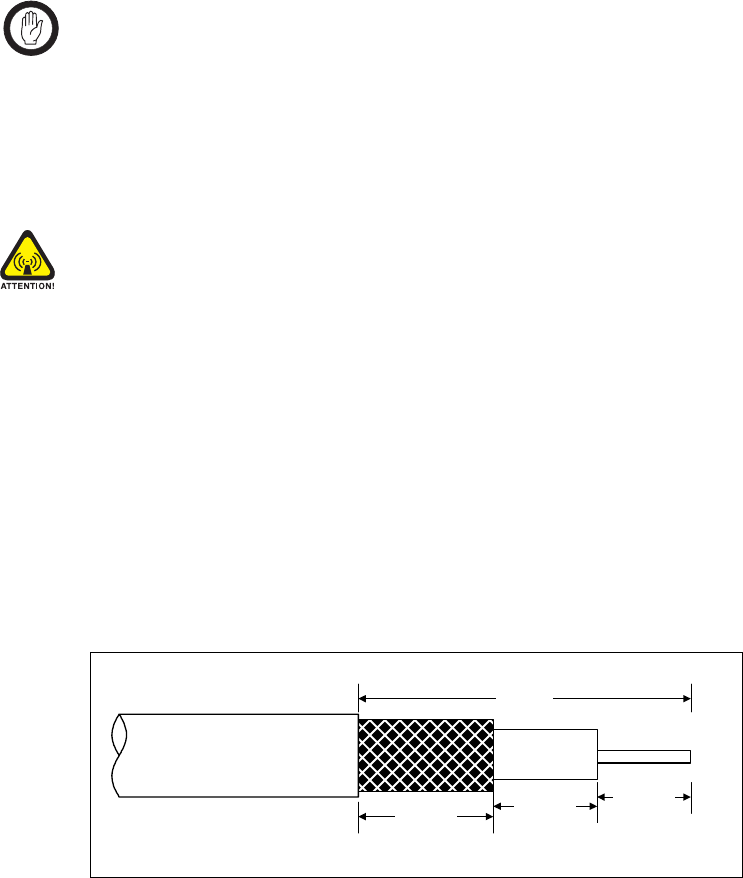
TM9100 Mobiles: 110 W Mobile Installation Guide Installing the Radio 13
© Tait Electronics Limited October 2005
4.2 Installing the Antenna
This section provides information on installing an external antenna within
the RF exposure limits.
Install the external antenna (not supplied) according to the antenna
manufacturer’s instructions. Good quality 50 Ω coaxial cable must be used,
such as RG58 or UR76.
Important Route the cable in a manner that minimizes:
■coupling into the electronic control systems of
the vehicle
■coupling of electric vehicle systems, such as alternators,
into the radio.
Avoid sharp bends in the cable. These distort the cable and
alter its electrical characteristics.
Warning!! RF exposure hazard
To comply with FCC RF exposure limits, mount the antenna at a location
such that no person or persons can come closer than 44 inches (1.1m) to the
antenna.
■VHF radios must be installed using an antenna mounted centrally
on the vehicle roof, with a gain of 2.15dBi or 5.15dBi.
Terminating the
Antenna Cable 1. Run the antenna cable (not supplied) from the antenna to the radio
mounting location and cut it to length, allowing approximately 8
inches (20 cm) excess at the radio end.
2. Strip the end of the coaxial cable as shown in Figure 4.1. Fit the right
angle N-type antenna connector (supplied) to the antenna cable.
Figure 4.1 Stripping the antenna cable
0.27 in
(6.8 mm)
0.33 in
(8.3 mm)
0.24 in
(6.0 mm)
0.83 in
(21 mm)

14 Installing the Radio TM9100 Mobiles: 110 W Mobile Installation Guide
© Tait Electronics Limited October 2005
4.3 Connecting the Power Cable to the Power Source
Power is supplied to the 110 W mobile via a cable with a DB25 connector
(provided). This plugs into the external RF amplifier, which provides power
to the back of the radio body via an internal loom.
Important This radio is designed to operate from a nominal 12V
negative ground supply and may draw up to 30A of current.
The radio will tolerate a supply voltage range of 10.8V to
16.6V at the radio.
Selecting the Power
Source In passenger vehicles, the radio is always connected directly to the battery.
In trucks, where direct connection to the battery is often not possible, the
radio can be connected to a suitable terminal inside the fuse box that is
connected directly to the battery.
24V-to-12V
Converter In vehicles with a supply voltage larger than 16.0V, such as many trucks, it
is essential to provide a suitably rated 24V-to-12V converter. This will
isolate the radio from excessive battery voltage and provide the correct DC
operating conditions. Note that most 24V-to-12V converters already fitted
are not rated sufficiently.
Standby Current When using the ignition signal to turn off the radio, the standby current is
reduced to <3mA. Otherwise, the standby current is 50mA.
Connecting the
Power Cable Important Although it is possible to connect the radio in line with the
vehicle ignition, this is not recommended, as it may draw
too much current and damage the vehicle wiring and
steering column or ignition switch. This may also cause the
supply voltage of the radio to drop below the specified level.
Important Disconnecting the vehicle’s battery may cause problems
with some electronic equipment, such as vehicle alarms,
engine management systems, and in-car entertainment
systems. Check that the vehicle owner has the necessary
information to make all electronic equipment function
correctly after battery reconnection.
Important If the battery is not disconnected, exercise extreme caution
during the installation and install the fuses only when the
installation is ready to be checked. For more information,
refer to “Checking the Installation” on page 22.
1. Disconnect the vehicle’s battery unless specifically prohibited from
doing so by the customer, vehicle manufacturer, agent, or supplier.
Important Route the cable in a manner that minimizes coupling of
electric vehicle systems such as alternators into the radio.

TM9100 Mobiles: 110 W Mobile Installation Guide Installing the Radio 15
© Tait Electronics Limited October 2005
Important Protect the power cable from engine heat, sharp edges and
from being pinched or crushed.
2. Run the supplied power cable (or one with a higher current rating)
between the radio’s mounting position and the vehicle battery (12 V)
and cut it to length, allowing approximately 8 inches (20 cm) excess
at the radio end.
3. Cut the negative (black) and the positive (red) wires where the in-line
fuse holders will be placed (as close to the power source as possible).
Important Do not install the fuses until the installation is ready to be
checked. For more information, refer to “Checking the
Installation” on page 22.
4. Insert each end of the negative wire into each of the fuse
crimp-terminals and crimp them to force the metal contacts onto
the wires.
5. Push the two crimp-terminals into the clear plastic fuse cover. Close
the cover while the next steps are completed.
6. Repeat steps 4 and 5 for the positive wire.
7. Connect the negative wire to the battery ground terminal.
8. Connect the positive wire to the battery positive terminal.
Important Do not install the fuses until the installation is ready to be
checked. For more information, refer to “Checking the
Installation” on page 22.
4.4 Installing the Remote Control Head
1. Choose a suitable location for the control head.
2. Mount the Control Head according to the instructions supplied
(IPN: 402-00015-00). Make sure that you follow the warnings and
cautions in these instructions.
Note The remote control head back (TMAA03-03) has already been
fitted to the Control Head and the dual RJ-45 torso interface
(TMAC34-1T) has already been fitted to the radio body.)
3. Run the remote head cable (TMAA04-01) from the control head
location to the radio mounting location.
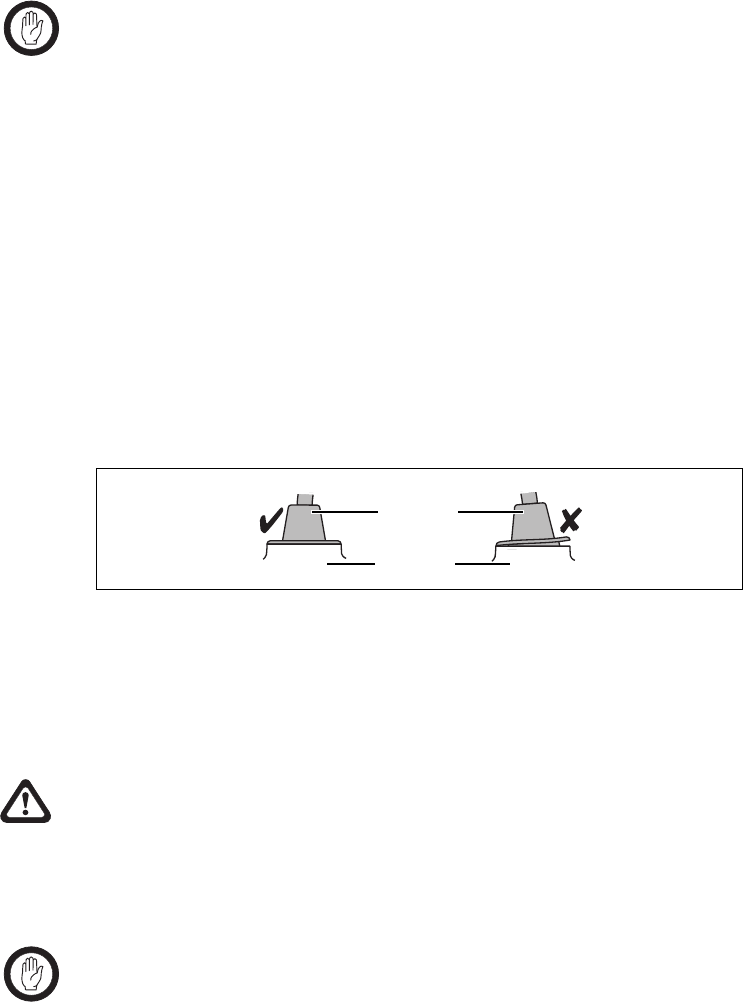
16 Installing the Radio TM9100 Mobiles: 110 W Mobile Installation Guide
© Tait Electronics Limited October 2005
4.5 Installing the Microphone
This section describes the radio’s microphone connector and the information
required to connect the microphone and install the microphone clip.
Important The microphone grommet must be installed whenever the
microphone is plugged into the microphone socket:
■to prevent damage to the microphone socket when
there is movement of the microphone cord, and
■to ensure that the control head is sealed against water,
dust and other environmental hazards.
Connecting the
Microphone 1. Plug the microphone into the microphone socket.
2. Slide the grommet along the microphone cord and push two adjacent
corners of the grommet into the microphone socket cavity.
3. Squeeze the grommet and push the remaining corners into position.
4. Check that the grommet is seated correctly in the cavity.
Installing the
Microphone Clip Install the microphone clip in the most convenient location using the screws
provided. The microphone must be within reach of the user but in such a
position that the PTT (press-to-talk) key cannot be inadvertently activated
or jammed.
Warning!! Safe microphone mounting
■Mount the microphone where it will not interfere with:
■the deployment of passenger airbags
■the vehicle operator controls
■the vehicle operator’s view.
Important Only install the microphone clip provided. If a non-
standard microphone clip is used, the correct operation of
the microphone hookswitch cannot be guaranteed.
Figure 4.2 Correct microphone and remote cable grommet seating
microphone
grommet
control head
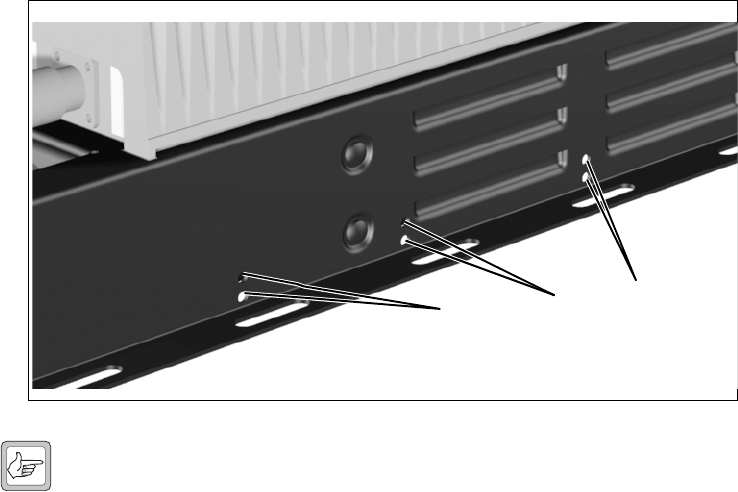
TM9100 Mobiles: 110 W Mobile Installation Guide Installing the Radio 17
© Tait Electronics Limited October 2005
4.6 Connecting to the Ignition Signal
Ignition Sense allows the radio to be turned on and off with the ignition key
of the vehicle. The TM9155R is already fitted with an ignition sense kit,
however it must be programmed for ignition sense operation.
If Ignition Sense operation is desired:
1. Make sure that the AUX GP13 line has been programmed for
ignition sense.
2. Run the yellow wire from the back of the mobile body (underneath
the 110W RF Amplifier) to a 12V signal controlled by the ignition
key.
3. Secure the cable with cable ties using the small holes in the side of the
chassis.
Note The logic thresholds for AUX GPI3 are based on 3V3 levels.
However, AUX GPI3 can be connected directly to a +13.8V
ignition signal.
Figure 4.3 Holes for cable ties
Holes for cable ties

18 Installing the Radio TM9100 Mobiles: 110 W Mobile Installation Guide
© Tait Electronics Limited October 2005
4.7 Connecting a Remote Speaker
If a high-power remote speaker is required, Tait recommends using:
■TMAA10-03 high-power remote speaker for 25W radios.
Installation instructions (IPN 402-00010-00) are provided with the speaker.
If a different speaker is used, receptacles for the speaker pins of the power
connector are provided with the installation kit.
1. Run the speaker cable to the radio, then (underneath the RF
amplifier) alongside the ignition sense cable to the back of the radio
body.
2. Secure the speaker cable with cable ties using the small holes in the
side of the chassis (see Figure 4.3 on page 17), as was done for the
ignition sense cable.
3. Connect the speaker to pins 2 (SPK–) and 3 (SPK+) of the radio
body’s power connector (see Table 4.1).
4.8 Connecting to an Emergency Switch and/or
External Alert Devices
The auxiliary connector can be used to connect external devices and signals
that are typically connected to a radio. These devices and signals include:
■an emergency switch to power up the radio (if required) and then enter
emergency mode
■external alert devices.
If you want to connect an external device or signal, first check Table 4.2 to
see whether the signal is already used by the 100W RF amplifier.
If the signal is available, disconnect the loom between the RF amplifier and
the radio body. Open up the auxiliary connector (DB15) and wire in the
desired signal.
Table 4.1 Radio body power connector—pins and signals
Pinout Pin Signal name Description Signal type
1 AGND Earth return for radio body power source Ground
2 SPK– External speaker output. Balanced load
configuration
Analog
3 SPK+ External speaker output. Balanced load
configuration
Analog
4 13V8 BATT DC power input for radio body and
control head
Power
1 2 3 4
rear view

TM9100 Mobiles: 110 W Mobile Installation Guide Installing the Radio 19
© Tait Electronics Limited October 2005
Emergency Switch The radio allows for connection of an emergency switch to any input line
to enter the emergency mode. If the switch is connected to the AUX GPI2
input line, the radio can also use ‘emergency power sense’ to power up the
radio to enter the emergency mode.
Note The selected input line must be programmed to ‘Enter Emergency
Mode’ and active to ‘Low’. To use ‘emergency power sense’,
hardware link LK3 must be fitted (factory default), and AUX GPI2
Table 4.2 Auxiliary connector (radio)—pins and signals
Pinout Pin Signal name Description Signal type
12 AUX GPI11
1. Used by the 100W RF amplifier
General purpose digital
input. Programmable
function
Digital,
3V3 CMOS.
5 AUX GPI2
4 AUX GPI3 General purpose input
(ignition sense)
3V3 levels.
Protected for
+13.8V.
10 AUX GPIO4 Programmable function and
direction
Pads available to fit a higher
power driver transistor on
GPIO4 line
Digital, 3V3
CMOS input;
open collector
output with
pullup
2 AUX GPIO51
9 AUX GPIO61
1 AUX GPIO71
11 AUX TXD Asynchronous serial port -
Transmit data
Digital,
3V3 CMOS
3 AUX RXD Asynchronous serial port -
Receive data
Digital,
3V3 CMOS
7 AUD TAP IN Programmable tap point into
the Rx or Tx audio chain.
DC-coupled
Analog
13 AUD TAP OUT Programmable tap point out
of the Rx or Tx audio chain.
DC-coupled
Analog
14 AUX MIC AUD Auxiliary microphone input.
Electret microphone biasing
provided. Dynamic
microphones are not
supported
Analog
6 RSSI Analog RSSI output Analog
8 +13V8 SW Switched 13.8V supply.
Supply is switched off when
radio body is switched off
Power
15 AGND Analog ground Ground
rear view
J
B
C
D
E
F
G
H
I
1)
1!
1@
1#
1$
1%

20 Installing the Radio TM9100 Mobiles: 110 W Mobile Installation Guide
© Tait Electronics Limited October 2005
must be used. For more information, refer to the service manual
and the online help of the programming application.
Connect a normally open switch between the pin of the input line
(pin 5 for AUX GPI2) and pin 15 (AGND) of the
auxiliary connector.
External Alert Device The radio allows for output to external alert devices using the digital GPIO
lines of the auxiliary connector and the internal options connector.
AUX GPIO4 can be fitted with a power MOSFET (Q707) to directly
connect external alert devices (e.g. flashing light, buzzer, horn relay) to the
radio. Also, resistor R768 must be removed.
Important While the MOSFET is rated at 12 A (with heat sink), the
maximum allowable current of the connector and radio’s
earthing system is 2 A. Therefore, a horn must not be
connected directly to the radio. A horn relay must be used.
Note The selected output line must be programmed to ‘External Alert 1
or 2’, active to ‘Low’, and signal state to ‘Momentary’.
Connect the external alert device to the pin of the output line (pin 10
for AUX GPIO4) and pin 8 (+13V8 SW) of the auxiliary connector
(or a different positive battery connection).
This means that the negative side of the alert device must be con-
nected to AUX GPIO4 and the positive side to pin 8 (+13V8 SW).
The external alert device must be capable of accepting a voltage of
between 10V and 18V.
4.9 Mounting the Radio
Once the cables are all in position, you attach them to the radio and secure
it in its mounting location. The procedure varies, depending on whether
you are using the base plate and cover.
Warning!! Mount the radio securely so that it will not break loose
in the event of a collision.
To mount the radio without using the base plate and cover:
1. Locate the 110W Mobile chassis in the mounting location and drill
mounting holes.
2. Connect the Control Head cable, Antenna cable and External
Speaker (if installed). Lastly, connect the power cable.
3. Fix the 110W Mobile chassis securely to the mounting surface.
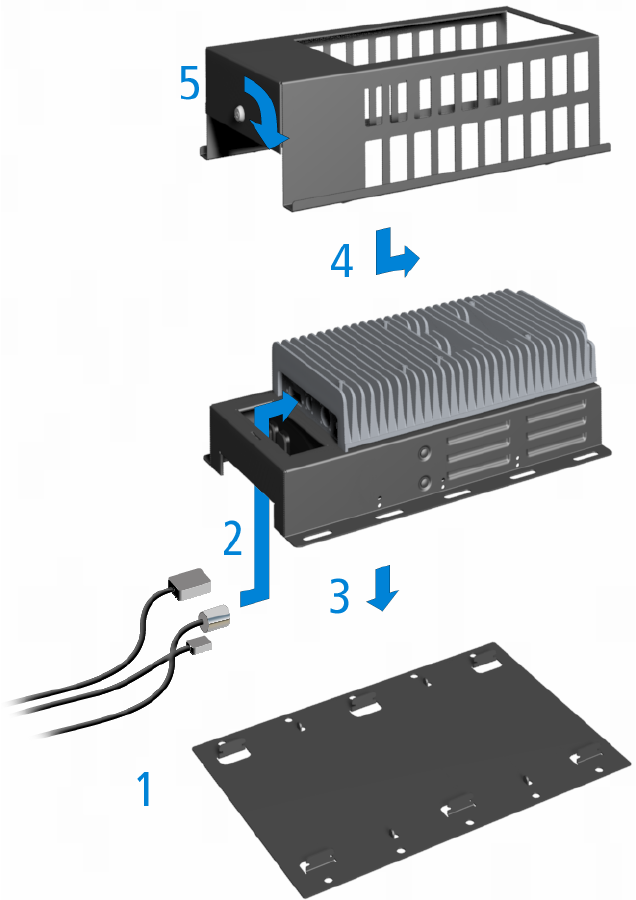
TM9100 Mobiles: 110 W Mobile Installation Guide Installing the Radio 21
© Tait Electronics Limited October 2005
To mount the radio using the base plate and cover:
1. Fix the base plate securely to the mounting surface.
2. Connect the Control Head cable, Antenna cable and External
Speaker (if installed), to the 110W Mobile. Lastly, connect the power
cable.
3. Place the 110W Mobile onto the base plate.
4. Fit the cover over the 110W Mobile and then slide it forward 5mm
(1/4") to engage with the base plate.
5. Using the key supplied, turn the lock to lock the cover in place.

22 Installing the Radio TM9100 Mobiles: 110 W Mobile Installation Guide
© Tait Electronics Limited October 2005
4.10 Checking the Installation
Warning!! Danger of fire. The radio’s protection mechanisms rely
on the correct fuses on both the negative and positive
power supply leads being present. Failure to fit the
correct fuses may result in fire or damage to the radio.
Make sure that you use 30 A fuses. For part numbers,
refer to “Checking the Equipment for Completeness”
on page 10.
1. Insert the fuses into the power leads.
2. Turn the ignition on. If necessary, switch on the radio at the control
head.
3. Confirm that it is operational, but do not transmit.
4. Connect an in-line power meter between the radio and the antenna.
5. Transmit and measure the forward and reflected power levels.
The antenna system should achieve a VSWR of better than 2:1. If
VSWR is poor (3:1 or worse), the External RF Amplifier will reduce
its RF power output.
6. If the VSWR is not better than 2:1, check the installation. If
necessary, start reducing the length of the antenna in steps of 0.1
inches to 0.2 inches (2 to 5 mm). Measure the power levels at each
step. For wide-band use, tune for best performance at the top of the
band.
Important Some antennas are pre-tuned and must not be cut. Check
with the manufacturers’ instructions.
7. Once the VSWR is within tolerance, make a call to another party on
the radio.

TM9100 Mobiles: 110 W Mobile Installation Guide Tait General Software Licence Agreement 23
© Tait Electronics Limited October 2005
Tait General Software Licence Agreement
This legal document is an Agreement between you (the
“Licensee”) and Tait Electronics Limited (“Tait”). By using any
of the Software or Firmware items prior-installed in the related
Tait product, included on CD or downloaded from the Tait
website, (hereinafter referred to as “the Software or Firmware”)
you agree to be bound by the terms of this Agreement. If you do
not agree to the terms of this Agreement, do not install and use
any of the Software or Firmware. If you install and use any of the
Software or Fir mware that will be deemed to be acceptance of the
terms of this licence agreement.
The terms of this Agreement shall apply subject only to any
express written terms of agreement to the contrary between Tait
and the Licensee.
Licence
TAIT GRANTS TO YOU AS LICENSEE THE NON-EXCLUSIVE
RIGHT TO USE THE SOFTWARE OR FIRMWARE ON A SINGLE
MACHINE PROVIDED YOU MAY ONLY:
1. COPY THE SOFTWARE OR FIRMWARE INTO ANY MACHINE
READABLE OR PRINTED FORM FOR BACKUP PURPOSES IN
SUPPORT OF YOUR USE OF THE PROGRAM ON THE SINGLE
MACHINE (CERTAIN PROGRAMS, HOWEVER, MAY INCLUDE
MECHANISMS TO LIMIT OR INHIBIT COPYING, THEY ARE
MARKED “COPY PROTECTED”), PROVIDED THE COPYRIGHT
NOTICE MUST BE REPRODUCED AND INCLUDED ON ANY SUCH
COPY OF THE SOFTWARE OR FIRMWARE;
AND / OR
2. MERGE IT INTO ANOTHER PROGRAM FOR YOUR USE ON
THE SINGLE MACHINE (ANY PORTION OF ANY SOFTWARE OR
FIRMWARE MERGED INTO ANOTHER PROGRAM WILL
CONTINUE TO BE SUBJECT TO THE TERMS AND CONDITIONS
OF THIS AGREEMENT).
THE LICENSEE MAY NOT DUPLICATE, MODIFY, REVERSE
COMPILE OR REVERSE ASSEMBLE ANY SOFTWARE OR
FIRMWARE IN WHOLE OR PART.
Important Notice
THE SOFTWARE OR FIRMWARE MAY CONTAIN OPEN SOURCE
SOFTWARE COMPONENTS (“OPEN SOURCE COMPONENTS”).
OPEN SOURCE COMPONENTS ARE EXCLUDED FROM THE
TERMS OF THIS AGREEMENT EXCEPT AS EXPRESSLY STATED IN
THIS AGREEMENT AND ARE COVERED BY THE TERMS OF THEIR
RESPECTIVE LICENCES WHICH MAY EXCLUDE OR LIMIT ANY
WARRANTY FROM OR LIABILITY OF THE DEVELOPERS AND/OR
COPYRIGHT HOLDERS OF THE OPEN SOURCE COMPONENT
FOR THE PERFORMANCE OF THOSE OPEN SOURCE
COMPONENTS. YOU AGREE TO BE BOUND BY THE TERMS AND
CONDITIONS OF EACH SUCH LICENCE. FOR MORE
INFORMATION SEE:
HTTP://SUPPORT.TAITWORLD.COM/GO/OPENSOURCE
Title to Software
THIS AGREEMENT DOES NOT CONSTITUTE A CONTRACT OF
SALE IN RELATION TO THE SOFTWARE OR FIRMWARE SUPPLIED
TO THE LICENSEE. NOT WITHSTANDING THE LICENSEE MAY
OWN THE MAGNETIC OR OTHER PHYSICAL MEDIA ON WHICH
THE SOFTWARE OR FIRMWARE WAS ORIGINALLY SUPPLIED, OR
HAS SUBSEQUENTLY BEEN RECORDED OR FIXED, IT IS A
FUNDAMENTAL TERM OF THIS AGREEMENT THAT AT ALL
TIMES TITLE AND OWNERSHIP OF THE SOFTWARE OR
FIRMWARE, WHETHER ON THE ORIGINAL MEDIA OR
OTHERWISE, SHALL REMAIN VESTED IN TAIT OR THIRD
PARTIES WHO HAVE GRANTED LICENCES TO TAIT.
Term and Termination
THIS LICENCE SHALL BE EFFECTIVE UNTIL TERMINATED IN
ACCORDANCE WITH THE PROVISIONS OF THIS AGREEMENT.
THE LICENSEE MAY TERMINATE THIS LICENCE AT ANY TIME BY
DESTROYING ALL COPIES OF THE SOFTWARE OR FIRMWARE
AND ASSOCIATED WRITTEN MATERIALS. THIS LICENCE WILL BE
TERMINATED AUTOMATICALLY AND WITHOUT NOTICE FROM
TAIT IN THE EVENT THAT THE LICENSEE FAILS TO COMPLY
WITH ANY TERM OR CONDITION OF THIS AGREEMENT. THE
LICENSEE AGREES TO DESTROY ALL COPIES OF THE SOFTWARE
OR FIRMWARE AND ASSOCIATED WRITTEN MATERIALS IN THE
EVENT OF SUCH TERMINATION.
Limited Warranty
THE SOFTWARE OR FIRMWARE (INCLUDING OPEN SOURCE
COMPONENTS) IS SUPPLIED BY TAIT AND ACCEPTED BY THE
LICENSEE “AS IS” WITHOUT WARRANTY OF ANY KIND EITHER
EXPRESSED OR IMPLIED, INCLUDING BUT NOT BEING LIMITED
TO ANY IMPLIED WARRANTIES AS TO MERCHANTABILITY OR
FITNESS FOR ANY PARTICULAR PURPOSE. THE LICENSEE
ACKNOWLEDGES THAT THE SOFTWARE OR FIRMWARE
(INCLUDING OPEN SOURCE COMPONENTS) IS USED BY IT IN
BUSINESS AND ACCORDINGLY TO THE MAXIMUM EXTENT
PERMITTED BY LAW NO TERMS OR WARRANTIES WHICH ARE
IMPLIED BY LEGISLATION SHALL APPLY TO THIS AGREEMENT.
TAIT DOES NOT WARRANT THAT THE FUNCTIONS CONTAINED
IN THE SOFTWARE OR FIRMWARE (INCLUDING OPEN SOURCE
COMPONENTS) WILL MEET THE LICENSEE’S REQUIREMENTS OR
THAT THE OPERATION OF THE SOFTWARE OR FIRMWARE
(INCLUDING OPEN SOURCE COMPONENTS) WILL BE
UNINTERRUPTED OR ERROR FREE.
Exclusion of Liability
IN NO CIRCUMSTANCES SHALL TAIT BE UNDER ANY LIABILITY
TO THE LICENSEE, OR ANY OTHER PERSON WHATSOEVER,
WHETHER IN TORT (INCLUDING NEGLIGENCE), CONTRACT
(EXCEPT AS EXPRESSLY PROVIDED IN THIS AGREEMENT),
EQUITY, UNDER ANY STATUTE, OR OTHERWISE AT LAW FOR
ANY LOSSES OR DAMAGES WHETHER GENERAL, SPECIAL,
EXEMPLARY, PUNITIVE, DIRECT, INDIRECT OR
CONSEQUENTIAL ARISING OUT OF OR IN CONNECTION WITH
ANY USE OR INABILITY OF USING THE SOFTWARE OR
FIRMWARE (INCLUDING OPEN SOURCE COMPONENTS).
THE LICENSEE’S SOLE REMEDY AGAINST TAIT WILL BE LIMITED
TO BREACH OF CONTRACT AND TAIT’S SOLE AND TOTAL
LIABILITY FOR ANY SUCH CLAIM SHALL BE LIMITED AT THE
OPTION OF TAIT TO THE REPAIR OR REPLACEMENT OF THE
SOFTWARE OR FIRMWARE OR THE REFUND OF THE PURCHASE
PRICE OF THE SOFTWARE OR FIRMWARE.
General
THE LICENSEE CONFIRMS THAT IT SHALL COMPLY WITH THE
PROVISIONS OF LAW IN RELATION TO THE SOFTWARE
OR FIRMWARE.
Law and Jurisdiction
THIS AGREEMENT SHALL BE SUBJECT TO AND CONSTRUED IN
ACCORDANCE WITH NEW ZEALAND LAW AND DISPUTES
BETWEEN THE PARTIES CONCERNING THE PROVISIONS
HEREOF SHALL BE DETERMINED BY THE NEW ZEALAND
COURTS OF LAW. PROVIDED HOWEVER TAIT MAY AT ITS
ELECTION BRING PROCEEDINGS FOR BREACH OF THE TERMS
HEREOF OR FOR THE ENFORCEMENT OF ANY JUDGEMENT IN
RELATION TO A BREACH OF THE TERMS HEREOF IN ANY
JURISDICTION TAIT CONSIDERS FIT FOR THE PURPOSE OF
ENSURING COMPLIANCE WITH THE TERMS HEREOF OR
OBTAINING RELIEF FOR BREACH OF THE TERMS HEREOF.
No Dealings
THE LICENSEE MAY NOT SUBLICENSE, ASSIGN OR TRANSFER
THE LICENCE OR THE PROGRAM EXCEPT AS EXPRESSLY
PROVIDED IN THIS AGREEMENT. ANY ATTEMPT OTHERWISE TO
SUBLICENSE, ASSIGN OR TRANSFER ANY OF THE RIGHTS,
DUTIES OR OBLIGATIONS HEREUNDER IS VOID.
No Other Terms
THE LICENSEE ACKNOWLEDGES THAT IT HAS READ THIS
AGREEMENT, UNDERSTANDS IT AND AGREES TO BE BOUND BY
ITS TERMS AND CONDITIONS. THE LICENSEE FURTHER AGREES
THAT SUBJECT ONLY TO ANY EXPRESS WRITTEN TERMS OF
AGREEMENT TO THE CONTRARY BETWEEN TAIT AND THE
LICENSEE THIS IS THE COMPLETE AND EXCLUSIVE STATEMENT
OF THE AGREEMENT BETWEEN IT AND TAIT IN RELATION TO
THE SOFTWARE OR FIRMWARE WHICH SUPERSEDES ANY
PROPOSAL OR PRIOR AGREEMENT, ORAL OR WRITTEN AND
ANY OTHER COMMUNICATIONS BETWEEN THE LICENSEE AND
TAIT RELATING TO THE SOFTWARE OR FIRMWARE.
24 Tait General Software Licence Agreement TM9100 Mobiles: 110 W Mobile Installation Guide
© Tait Electronics Limited October 2005